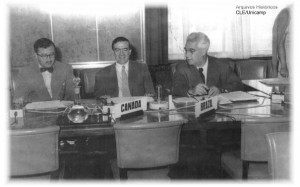|
|||||||||||||||||||||||||||||||||||||||
|
|||||||||||||||||||||||||||||||||||||||
Great part of the scientific activity of Prof. Bernhard Gross which came before his studies on electrets receive very little attention but are priceless. The papers on electrets started to have international prominence and repercussion after the 70’s and continued until early 80’s. I will comment a little about what he produced since the beginning of his career until the 60’s.
While still in Stuttgart, Germany, he published some papers about latitude corrections in detectors used to study cosmic rays in the atmosphere [references 1 and 2]. These articles were published in German. His work was soon generalized by E. J. Williams and published by Nature magazine [3]. Later on, this correction became known as “Gross’s transformation”. In the celebrated book about cosmic rays, published in 1950 [4], chapter 3 is dedicated to “Gross’s transformation”.
His first paper in Brazil was regarding electrical properties of zeolites [5] which, together with the work on delayed effects on dielectric solids [6] and, later on, on static charges on dielectrics [7], marked the beginning of his research in the field of Materials, which would culminate with famed studies about electrets after the 60’s. However, some seminal works on mathematical models applied to visco-elastic systems were very significant. These works were published in the last years of the 40’s [8-11]. As a result of this works, Gross published a book on the subject, which is still used as essential reference for the field of rheology of solids [12].
Circa 1950, Gross performed a series of studies on the effects of radiation on vitreous and polymeric systems [13.14]. With these studies, he discovered an electrical current in dielectric solids, which was related to the Compton Effect, originating celebrated and seminal work [15]. This effect explained the phenomenon occurring in nuclear plants, which had remained unexplained until then. The glass windows used as protection to radiation spontaneously cracked after being used for some time. Gross was invited by the Radiation Research Center in New York and, together with local researchers, he proved that Compton currents were responsible for the degradation of glass [16]. Right after that, Gross invented the Compton dosimeter [17], which he patented in the Unites States, but lost it for the American army after a legal battle.
Still in Brazil, Gross started his first studies about electrets [18, 19]; being the first to manufacture what he called radioelectrets. After retiring from the National Institute of Technology, he was invited to be in charge of the Department of Scientific and Technical Information of the International Agency of Atomic Energy, in Vienna, where he stayed until the end of the 60’s. He published some relevant papers about scientific information [20] and returns as a researcher in the field of electrets in the 70’s.
References
In June 1933, the physicist and engineer from Sttutgart, Germany, Bernhard Gross disembarked in the city of Rio de Janeiro. After developing some research on cosmic rays as a collaborator and coming to the conclusion that it was hard to find a job as a physicist in his country, the 28 year-old man decided to try a life in Brazil. At this point, Gross had already published a few scientific articles.
Why did Gross come to Brazil, a country that had very few institutions, infrastructure and human resources for research at the time? At an interview conducted in 1976, Gross said that his interest in Brazil started in his childhood, during a trip with the family to the cities of Rio de Janeiro, São Paulo, Porto Alegre and Pelotas, in which he had a taste of adventure and romance.
Right after his arrival in Rio, Gross spoke at a few lectures about cosmic rays at Escola Politécnica do Largo de São Francisco and, thus, he started to meet people connected to science in the city. In January 1934, he got his first job at the Institute of Meteorology. That same year, he published the first of many scientific articles written in Brazil. In 1999, at the age of 94, he would publish the last of around 200 articles.
Gross made internationally relevant and impressive contributions in various topics, such as Gama rays, electrical circuits and dielectric materials, with research developed in Brazil. Gross addressed scientific challenges with a lot of competence, from both the theoretical and the experimental point of view, and he gave specific attention to the application of Maths in Physics.
Besides doing science according to international standards, since the 30’s and 40’s, Gross published the results of his work in scientific journals in Brazil and abroad, such as the Annals of the Brazilian Academy of Science, the Journal of Applied Physics, Physical Review, Journal of Chemical Physics and the German magazine Zeitschrift für Angewandte Physik, among others. In addition, Gross traveled a lot around the world, spending some time working in the United States (at Bell labs and the Massachusetts Institute of Technology), in England (at Electrical Research Association), in Austria (as a member of the scientific committee for the International Agency of Atomic Energy, international organization dedicated to the pacific use of atomic energy), among other destinations. Finally, Gross managed to bring to Brazil researchers from abroad in many occasions.
By continuously working in various themes, Gross started in Brazil the research on Physics of Condensed Matter, the pillar of Materials Science and Engineering, in a pioneering way.
The electrets
One of the fields that received more scientific contributions from Bernhard Gross is the study of electrets, dielectric materials (insulators), which possess permanent electrical charge for being permanently polarized.
The genesis of Gross’s research about electrets refers to work produced by him in Brazil in 1934: a request from Light, the electricity and telephone company, who wanted to know which was the resistance of the isolation on their telephone cables. By making measures, Gross realized that the cables presented a phenomenon which had fascinated him for some time, called “dielectric absorption”.
In the interview of 1976, Gross reports: “What Light wished to know I could resolve within a reasonable amount of time. Now, I took the opportunity to study the behavior of insulators, in a more basic way.” Gross saw the technological interest in research activities as very important, without this limiting the scientific curiosity to a mere resolution of technological issue.
In the early 40’s, Gross and his team still researched on dielectric materials at the National Institute of Technology (INT) in Rio de Janeiro. Bernhard Gross had read about electrets and, due to sheer curiosity, he started to make a series of measures together with French researcher Line Ferreira-Denard, who worked at INT. The experimental work originated two initial publications in 1945 and in 1948, and it allowed them to explain for the first time the behavior of electrets. In 1957, Gross conducted a systematic study about the behavior of fields that were generated when, while injecting electrons in charged solids, electrons were stuck in “traps”.
It was also within the context of dielectrics and electrets that Joaquim da Costa Ribeiro developed the comprehension of the thermodynamic effect or “Costa Ribeiro effect”, in which a dielectric acquired permanent polarization and charge by means of the application of an external electical field.
The electret microphone
The knowledge developed by Gross about electrets enabled the advancement on industrial applications of this material, from which the most commonly known is the electret microphone, created inside Bell labs by Gerhard Sessler and James West, who applied for patent of the invention in 1962. Millions or billions of units of this kind of microphone have been produced per year.
In order to get to the electret microphone, Sessler and West used the theory developed by Gross and a method described by him to charge materials through electron beams. But researchers at Bell lab used as raw material Teflon leaves, whose mechanical properties, low conductivity and opportunity to be manufactured as thin plates allowed the application on microphones. A charged thin leaf of Teflon is moved by the action of sound vibrations and it induces electical charges, transforming sound vibrations into electrical vibrations.
“I admit that at the time I did not think of practical applications”, said Gross during the 1976 interview about the research on electrets. The scientist explained the reasons: he did not have adequate material for industrial application (he used carnauba wax and plexiglass); the difficulty in applying for patent at the time was too great and he needed to gather various skills in order to reach a device as a microphone.
The Sessler microphone was not the only one based on the knowledge developed by Gross. In the history of the Sttutgart physicist and his electrets, there was a case of direct technological exchange, related to Preston Murphy, his American assistant specialized in electrostatic. Gross met him in one of his travels and managed to get him a contract to work in Rio de Janeiro for the National Committee of Nuclear Energy. Murphy went to Brazil around 1957 and stayed for about six years, in which he gained knowledge and expertise. According to Gross, “when coming back to the US, I joined a company where he developed a kind of electrect microphone, based on the knowledge he acquired here, taking advantage of the American extraordinary capability to make gadgets, a virtue I do not possess. He arranged a few contracts there and assembled a big production line of electret microphones”.
Acknowledging the contribution of Gross in electrets
The advancement promoted by Gross in research on electrets was recognized worldwide. Gerhard Sessler dedicated the book “Electrets”, initially edited by him in 1980, to Bernhard Gross. In an article published in the Brazilian Journal of Physics in 1999, Sessler states that Gross laid the cornerstones of modern research on electrets, guided its evolution for over a century and helped establish the field as a respected subject of modern science.
In addition, international events of the field also honored the German physicist, like the 3rd and 5th International Symposium on Electrets, occurring respectively in São Carlos (Brazil) and Heidelberg (Germany) for Gross’s 70th and 80th birthday.
In Brazil, many scientists graduated under his influence. Among others, we can name Armando Dias Tavares, Francisco Oliveira Castro, Guilherme Leal Ferreira, Joaquim Costa Ribeiro, Plínio Sussekind Rocha, Roberto Faria, Sérgio Mascarenhas and Yvonne Mascarenhas. Research groups were inspired by Gross, especially in Rio de Janeiro and São Carlos, such as Grupo de Polímeros “Bernhard Gross“, created in the middle of the 70’s at USP São Carlos, from visits of Gross to the university.
In 2002, Bernhard Gross passed away in São Carlos, at the age of 97.
See also
More information:
O artigo científico em destaque neste mês é:
Volanti, D. P., Felix, A. A., Orlandi, M. O., Whitfield, G., Yang, D.-J., Longo, E., Tuller, H. L. and Varela, J. A. (2012), The Role of Hierarchical Morphologies in the Superior Gas Sensing Performance of CuO-Based Chemiresistors. Adv. Funct. Mater. doi: 10.1002/adfm.201202332
Texto de divulgação:
O papel da morfologia do óxido cúprico nanoestruturado na melhoria de suas propriedades sensoras.
Um trabalho de pesquisa desenvolvido em colaboração por pesquisadores do Instituto de Química da Universidade Estadual Paulista (Unesp) e do Departamento de Engenharia e Ciência dos Materiais do Massachusetts Institute of Technology (MIT) traz contribuições inovadoras ao desenvolvimento de sensores de alto desempenho para detecção de gases. O trabalho foi publicado online na prestigiada revista Advanced Functional Materials no final do ano passado.
Os pesquisadores decidiram investigar um material semicondutor de tipo-p, o óxido de cobre (II), também conhecido como óxido cúprico, cujo potencial na detecção de uma série gases já tinha sido demonstrado. Mais precisamente, a equipe pesquisou como a morfologia (formato) das partículas do óxido de cobre nanoestruturado influencia o desempenho do material como sensor de gás. “A síntese dos materiais nanoestruturados de óxido cúprico por um método hidrotérmico assistido por microondas era parte do trabalho de doutorado do então aluno Diogo P. Volanti”, contextualiza o professor José Arana Varela, um dos autores do artigo. “As morfologias obtidas eram únicas e, fazendo uma busca na literatura, notamos que havia muito poucos trabalhos que exploravam o uso de semicondutores do tipo-p como sensores de gás e que não havia nenhum trabalho que relatasse a influência da morfologia nestes semicondutores”, completa.
A investigação ocorreu no marco de um projeto de cooperação internacional entre o MIT e o Instituto de Química da Unesp, coordenado pelos professores José Arana Varela e Harry Tuller e financiado pela FAPESP (Projetos sementes MIT/BRASIL) e pelo CNPq (Bolsa de doutorado sanduíche). O projeto agregou o conhecimento do grupo da Unesp em síntese de novos materiais à experiência em caracterização em sensores de gás do grupo do MIT.
A equipe brasileira preparou, na Unesp, amostras de óxido cúprico com três morfologias diferentes e inovadoras: tipo ouriço, tipo fibra e tipo bastonete. A caracterização estrutural, morfológica e por microscopia eletrônica de transmissão das amostras também foi realizada no Brasil. Por sua vez, a equipe do MIT desenvolveu um sistema para testar a resposta à detecção de gás de todas as amostras simultaneamente e sob as mesmas condições. “Essa comparação in situ exatamente nas mesmas condições foi um fator de extrema relevância no estudo da influência da morfologia na resposta sensora”, afirma Anderson A. Felix, que foi o encarregado de realizar a caracterização sensora das amostras no MIT, no marco de seu doutorado sanduíche.
As amostras foram expostas a diversos gases em diferentes concentrações e temperaturas. As medidas mostraram que o controle da morfologia pode melhorar as propriedades sensoras do material. Em particular, revelou-se especialmente promissor como sensor de hidrogênio o formato de ouriço, formado por um núcleo sólido policristalino e espinhos nanoestruturados de aproximadamente 100 nanometros de comprimento e 10 de largura. De fato, essa morfologia apresentou uma sensibilidade muito maior do que as outras morfologias e também significativamente superior à sensibilidade de muitos outros materiais usados como sensores, mais caros e difíceis de fabricar do que o óxido cúprico.
“Do ponto de vista acadêmico, este trabalho foi muito importante ao mostrar um novo caminho para o aumento das propriedades sensoras em semicondutores do tipo-p”, diz Felix. “Do ponto de vista tecnológico, sensores baseados em cobre poderiam ser aplicados na área de segurança para sistemas a base de hidrogênio, como, por exemplo, células combustíveis”, completa.

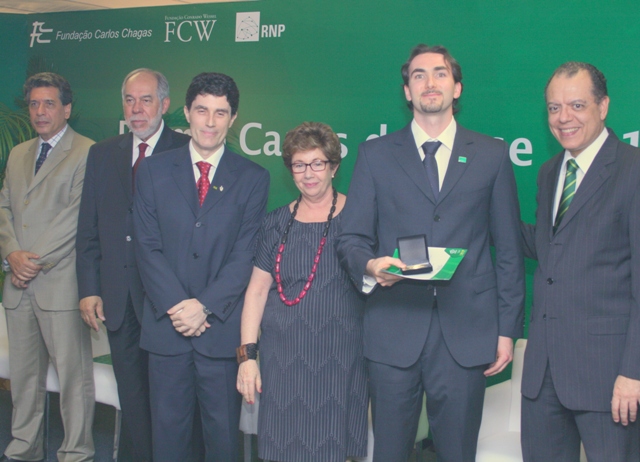
No dia 13 de dezembro passado, no edifício-sede da Capes, em Brasília, ocorreu a cerimônia de entrega do Prêmio Capes de Tese. Na área de Materiais, o prêmio foi outorgado a Cesar Aguzzoli (34 anos) pela tese “Avaliação das propriedades físico-químicas, mecânicas e tribológicas de filmes finos de VC, Si3N4 e TiN/Ti”, defendida em 2011. O trabalho foi orientado por Israel Baumvol, professor emérito da UFRGS e coordenador do Programa de Pós-Graduação em Materiais da Universidade de Caxias do Sul (PGMAT – UCS).
Aguzzoli fez graduação em Engenharia Química na UCS e mestrado em Engenharia e Ciência de Materiais na mesma universidade. Ele realizou o doutorado dentro de um programa interinstitucional (DINTER) vigente de 2007 a 2011 entre os programas de pós-graduação em Materiais da UFRGS e da UCS. Desde março do ano passado, Aguzzoli compõe o corpo docente do PGMAT – UCS.
Na tese contemplada com o Prêmio Capes de Tese, Aguzzoli estudou correlações entre estrutura e propriedades de alguns revestimentos baseados em filmes finos cerâmicos, mais especificamente, carbeto de vanádio, nitreto de silício e nitreto de titânio, depositados sobre titânio. As condições e os parâmetros de deposição dos filmes (composição e fluxo dos gases reativos, temperatura do substrato e outros) foram variados para obter filmes com composições, densidades e espessuras convenientes. Os resultados mostraram algumas correlações importantes entre, por um lado, dureza, resistência ao desgaste e resistência à corrosão e, por outro lado, composição, densidade real e estrutura cristalina.
Segue uma breve entrevista com o premiado.
Boletim da SBPMat (B.S.): – Poderia nos contar brevemente como começou o seu interesse pela ciência e como se desenvolveu a sua carreira de pesquisador?
Cesar Aguzzoli (C.A.): – O interesse pela ciência começou cedo em minha vida. Desde pequeno me interessei em saber como as coisas funcionam, fazendo diversas perguntas, tais como: O que está dentro disto? Como que estas peças juntas fazem isso possível? Então tive interesse em cursar uma graduação na área das exatas e escolhi o curso de Engenharia Química. No início da graduação comecei a ser bolsista de iniciação científica e então vieram algumas das respostas. Com a vontade de ter mais respostas e com uma infinidade de perguntas que surgiam a cada etapa, resolvi tentar a pós-graduação. Fiz mestrado e doutorado na área de Materiais. Então descobri que tinha mais perguntas que antes. Com isso, aprendi uma lição valiosa, perguntas sempre existirão e o gosto de achar respostas e formular perguntas é a carreira de pesquisador!
B.S.: – E por que começou a trabalhar na área de Materiais?
C.A.: – Bom, depois da graduação e com uma experiência em iniciação científica, surgiu a oportunidade de fazer mestrado em Materiais. Como sempre gostei desta área, mas ainda não tinha trabalhado nela, achei um desafio promissor e comecei os estudos em Materiais.
B.S.: – Quais foram os critérios que o guiaram para fazer uma pesquisa de qualidade destacada em nível nacional? A que fatores você atribui esta conquista?
C.A.: – Acredito que trabalhei com profissionais e colegas de alto nível. Isso sem nenhuma dúvida foi decisivo, bem como o comprometimento e dedicação que sempre achei necessários para o trabalho.
B.S.: – Gostaria de deixar alguma mensagem para nossos leitores que estão realizando trabalhos de iniciação científica, mestrado e doutorado na área de Materiais?
C.A.: – Com certeza, acredito que quando se faz algo que se gosta muito, tudo acaba ficando diferente. Pode não ser mais fácil, mas com certeza será menos sofrido. Acho que tanto para a vida como para o trabalho temos que possuir boa vontade e comprometimento com as tarefas. Com isso os resultados virão e, se não vierem, pelo menos o tempo que passamos fazendo as coisas não será um tempo gasto, e sim um investimento no que apreciamos em fazer.
Veja aqui o material de divulgação sobre o protótipo para fluoroimunoensaios desenvolvido no âmbito do INCT de Nanotecnologia para Marcadores Integrados (INAMI).
Estão abertas as inscrições do concurso para professor doutor do Departamento de Engenharia Metalúrgica e de Materiais da Escola Politécnica da Universidade de São Paulo (USP).
São duas vagas, uma na especialidade “Mecânica da Conformação dos Metais” (veja aqui o edital) e a outra na especialidade “Materiais Poliméricos” (acesse o edital).
A Assembleia Geral da Academia Brasileira de Ciências (ABC) elegeu 36 cientistas de excelência para integrar seus quadros como Membros Titulares e Membros Correspondentes. A cerimônia de posse ocorrerá no dia 7 de maio de 2013.
Entre os membros titulares eleitos, há três presidentes da Sociedade Brasileira de Pesquisa em Materiais (SBPMat): Roberto Mendonça Faria (USP), que é o presidente atual; José Arana Varela (Unesp), presidente de 2010 a 2011, e Elson Longo da Silva (Unesp), que presidiu a sociedade de 2004 a 2005. Os dois primeiros foram eleitos na área de Ciências Físicas e o terceiro, em Ciências Químicas.
Os novos membros da ABC foram eleitos em um processo de indicação e avaliação por pares que envolveu os membros titulares da academia.
Veja aqui notícia no site a ABC com a lista completa dos membros eleitos neste ano.
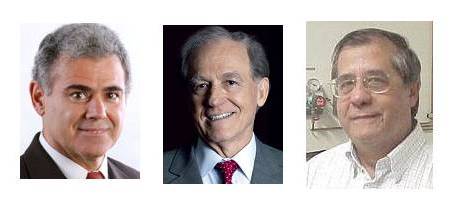
|
|||||||||||||||||||||||||||||||||||||||||||||
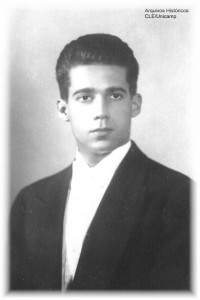
Graduated as a civil engineer and mechanical electrician engineer in 1928 by the Brazilian National School of Engineering, Costa Ribeiro became a lecturer at the newly founded University of Brazil (today UFRJ) and became part of the National Institute of Technology, which had a better laboratory infrastructure than the university. Thus, Costa Ribeiro participated in two of the very few institutions devoted to teaching and research in science existing in Brazil at the time.
Since 1943, Costa Ribeiro worked with German physicist Bernard Gross, who arrived in Brazil in 1933 and organized the first physics course in Rio de Janeiro two years later. Costa Ribeiro and Gross, giants of Brazilian science, can be considered the national pioneers of condensed matter physics, discipline that is among the pillars of the materials field. By the time they developed their studies, research in Physics in Brazil focused on the Nuclear and Particle fields, developed by scientists such as Cesar Lattes, Mário Schenberg and Jayme Tiomno.
Initially, Costa Ribeiro studied new methods for measuring radioactivity and applying them to Brazilian minerals, achieving notable contributions. Then, he began studying dielectric materials (solid electrical insulators), such as naphthalene and carnauba wax (typical palm tree from Northeastern Brazil), and electrets (solids with quasi-permanent electric charge).
It was then that Costa Ribeiro first observed an interesting effect while working with some dielectric materials. Fusion by heating without the application of external electric fields, caused an electric current to appear in the insulating material. Once solidified, the samples remained charged, constituting electrets. In conclusion, all it took for forming the electret, was the natural solidification of dielectric material after being melted by heating. According to Bernard Gross´s memory, recovered in an article by Professor Guilherme Leal Ferreira , this first experiment was performed with carnauba wax.
The elucidation of the phenomenon
In an interview of the Historical Archives of CLE/Unicamp, held in 1988, scientists Jayme Tiomno and Elisa Frota Pessoa, who were Costa Ribeiro´s students and his aides in the thermal-dielectric effect, shared their memories about the process that led to the elucidation of the phenomenon. According to them, in 1943, Costa Ribeiro decided to take the examination for the position of Professor in the University of Brazil, for which he had to prepare a thesis with original research. The professor then took the suggestion of Bernard Gross and studied pure organic electrets.
“He started by repeating the preparation of the electret using naphthalene and observing its properties. (…) He worked intensely, usually in the afternoons and evenings. One night, after putting the molten naphthalene in a cell to solidify and apply the electric field, he had to stop and leave. On the next day, he removed the naphthalene solid disc to melt and restart, but he decided to examine it using the electrometer. It was an electret!”
Yet, this was not the thermo-dielectric effect, but a static effect, according to Tiomno, who described: “After preparing several electrets without the application of an external electric field, he realized that the effect was stronger when cooling was faster – it was an effect of solidification rate. He, then, built an ingenious and very-well finished apparatus with which he could observe the movement of the liquid naphthalene interface with that solidified by cooling, simultaneously measuring the solidification rate (or melting) and the intensity of the electric current detected in a Wulf electrometer. Upon the verification of the correlation of these quantities, the thermo-dielectric phenomenon or Costa Ribeiro effect was discovered.
Dissemination of the research
Ribeiro´s first publication describing the effect is dated 1943. Entitled “Sobre a eletrização da cera de carnaúba na ausência de campo elétrico exterior“, the communication was made in the form of a presentation to the Brazilian Academy of Science and then, in an article published in the records of the institution. In 1945, the thermo-dielectric effect was subject of a thesis presented by Costa Ribeiro to the National Faculty of Philosophy of the University of Brazil in the examination for a position of Professor of General and Experimental Physics. In 1953, the Brazilian Academy of Science awarded him the Einstein Award for the thermo-dielectric effect.
In the interview to CLE/Unicamp, Jayme Tiomno and Elisa Pessoa also talked about the dissemination of the effect abroad. According to them, it began by Costa Ribeiro in Argentina, in meetings of the Argentinian Physics Association in 1945 and 1948. Also in 1948, invited by the University of Paris, Costa Ribeiro conducted three lectures at Sorbonne. In 1951, a summary of his work, which had been published in English in the Records of the Brazilian Academy of Science, was indexed in the “Physics Abstracts”. In 1954, the scientist held four lectures on his research, in the United States, at the Massachusetts Institute of Technology, in the Bureau of Standards (current National Institute of Standards and Technology), at Yale University and at General Electric.
In May 1950, US scientists Everly J. Workman and Steve E. Reynolds published a paper in Physical Review describing the same phenomenon, observed by them in the phase transition between water and ice. Consequently, the phenomenon of electrification of insulating materials in such change phase is reported in literature under various names, sometimes “Costa Ribeiro effect”, sometimes “Workman-Reynolds effect” or, simply “thermo-dielectric effect.”
The article by Professor Leal Ferreira on the Costa Ribeiro effect states that it is known today that the phenomenon of electrification of dielectrics generated by their solidification had been mentioned in the eighteenth century by Stephen Gray, one of the pioneers of experimental studies on electrical conduction. Ferreira highlights in his article that much beyond the merit of priority of discovery, there is Joaquim Costa Ribeiro´s merit of persistence in experimentally studying the effect found – merit increased by the precarious conditions of work at the time in Brazil.
Despite having a tendency of “getting by” alone, from the construction of his laboratory tools to the interpretation of results, Costa Ribeiro had collaborators in his studies on thermo-dielectric effect. Tiomno, for instance, contributed greatly to the theoretical part, up to a point where he was given a special thanks from the Professor in the thesis presented to the University of Brazil. Armando Dias Tavares and Sergio Mascarenhas were also collaborators and followers of research on the topic.
Regarding the effect applications, Mascarenhas says that the phenomenon has more fundamental than applied science value, although there are some applications, as described in a 1968 article about its use in aeronautical sector radiometers (L.D. Russel and B.H. Beam, Journal of Spacecraft and Rockets, vol. 5, pg. 1501, 1968). “Unfortunately, the effect is little taught in traditional courses,” laments Mascarenhas.
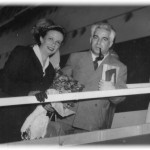
More about Joaquim Costa Ribeiro
Married to a French woman, to whom he dedicated many of his poems, Costa Ribeiro was the father of eight children. In order to support his family, at a time when university professors earned a few minimum wages, the scientist had multiple concurrent jobs. He taught at several institutions and schools.
Co-workers and relatives describe him with adjectives like: humanistic, serene, humble, resourceful, self-educated, handy, intuitive, intelligent and thorough.
Very catholic, questioned by his students on how to reconcile religion and science, he said: “It’s simple, I completely separate them. When I am in religion, I am in religion; when I am in science, I am in science”.
In addition to his scientific contributions, Costa Ribeiro played important roles in creating the Brazilian Center for Physical Research, CBPF, (1949) and the Brazilian Federal Council for Scientific and Technological Developmente, CNPq, (1951). He also participated in several national and international initiatives on the use of nuclear energy.
He died in 1960 in Rio de Janeiro.
